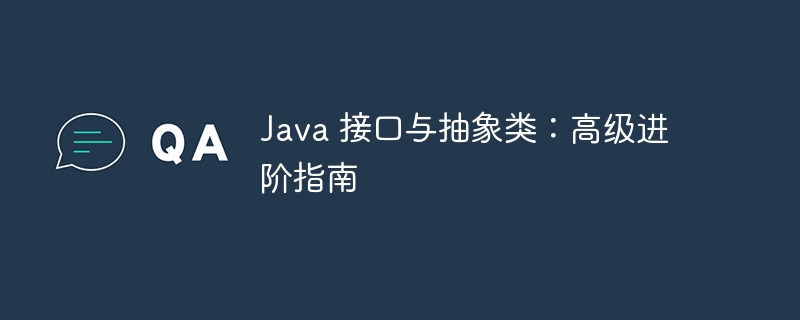Home >Java >javaTutorial >Java Interfaces and Abstract Classes: An Advanced Guide
Java Interfaces and Abstract Classes: An Advanced Guide
- WBOYWBOYWBOYWBOYWBOYWBOYWBOYWBOYWBOYWBOYWBOYWBOYWBforward
- 2024-03-27 11:36:50651browse

Java Interfaces and abstract classes are important concepts in Java object-oriented programming. Mastering their usage skills is crucial to improving code quality and maintainability. PHP editor Apple has carefully compiled this advanced advanced guide, which will deeply explore the differences, applicable scenarios and best practices between Java interfaces and abstract classes to help readers better understand and use these two key features. Whether you are a beginner or an experienced Java developer, this article will provide you with useful guidance and inspiration.
Advantage:
- Enforce polymorphism, ensuring that implementation classes have the same method signature.
- Provides loose coupling, allowing interfaces and implementation classes to be developed and maintained independently.
- Promote code reuse by sharing common behavior definitions.
limitation:
- cannot contain any implementation code.
- Unable to instantiate interface.
Abstract class An abstract class is a partially implemented class that contains abstract methods and concrete methods. Abstract methods must be implemented in subclasses, while concrete methods provide default implementations.
Advantage:
- Provides polymorphism and loose coupling, similar to interfaces.
- Allows implementation code to be included, thus promoting code reuse.
- An abstract class can be instantiated if it contains concrete implementations of all abstract methods.
limitation:
- Polymorphism is not enforced, subclasses can override specific methods.
- The degree of coupling is higher than that of interfaces, because subclasses depend on the implementation of abstract classes.
Choose interface or abstract class The choice of interface or abstract class depends on the needs of the specific scenario.
- Use interfaces: When forced polymorphism, loose coupling, and no specific implementation are required.
- Use abstract classes: When shared behavior is required and you need to provide partial implementation or force subclasses to implement specific methods.
Advanced Advanced Guide
interface:
- Use the marking interface (empty interface) to mark the class as belonging to a specific category.
- Create a hierarchical structure by inheriting the extended interface.
- Consider using internal interfaces to improve encapsulation and modularity.
Abstract class:
- Create instances of abstract classes through the abstract factory pattern.
- Use the template method pattern to provide custom hooks in subclasses.
- Consider using the bridge pattern to separate abstract classes from implementation.
Best Practices:
- Use clear and concise naming conventions.
- Avoid creating too many interfaces or abstract classes.
- Follow SOLID principles such as single responsibility and Liskov substitution principle.
in conclusion Interfaces and abstract classes are powerful tools in Java Programming for achieving abstraction and polymorphism. Understanding their differences and high-level tutorials is critical so you can effectively leverage these mechanisms and write more robust and flexible code.
The above is the detailed content of Java Interfaces and Abstract Classes: An Advanced Guide. For more information, please follow other related articles on the PHP Chinese website!
Related articles
See more- What is Java interface
- Encapsulated code review strategies in PHP
- Performance optimization examples of encapsulation in PHP
- Statistical chart design for multi-dimensional data analysis based on ECharts and Java interface
- ECharts and Java interface: How to quickly implement statistical charts such as line charts, bar charts, pie charts, etc.

